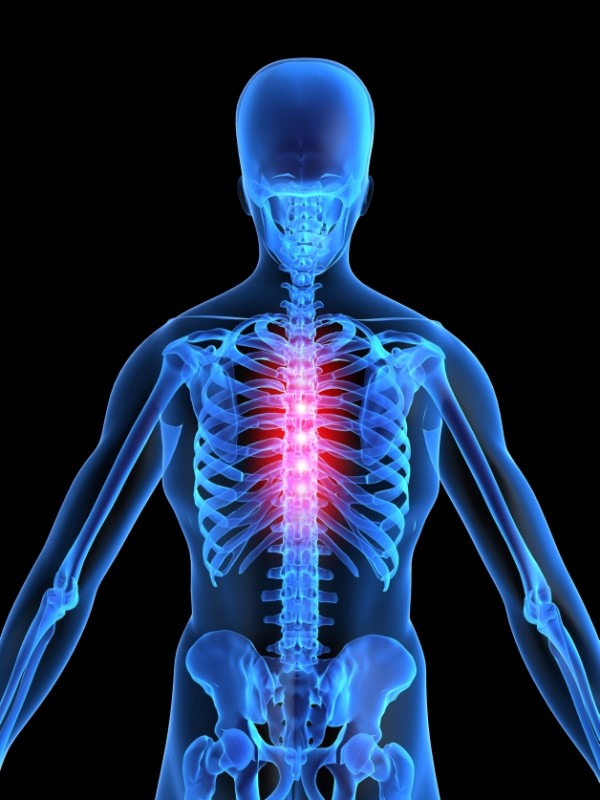Some degree of rounded curvature of the spine is normal. The term kyphosis is used to describe the spinal curve that results in an abnormally rounded back. Resulting symptoms may include pain in the upper back, numbness, pain or tingling from the upper back and around the chest, leg weakness and chest pain.
- Postural Kyphosis – the most common type of kyphosis. It is acquired as a result of poor postural habits such as slouching. It represents an exaggerated, but flexible, increase of the natural curve of the spine.
- Sheuermann’s Kyphosis – develops over time during periods of bone growth (such as puberty). It occurs when the front of the spine doesn’t grow as fast as the back of the spine and causes healthy, rectangular-shaped vertebrae to become triangular-shaped and wedged together. This causes the thoracic spine to curve more than normal. Patients become stooped forward with a bent-over posture.
Mechanical back pain refers to pain related to the structure of the back and occurs when one of the joints in the thoracic or lumbar spine loses its normal joint mobility (resiliency and shock absorption). When a joint develops dysfunction, its normal movement may be affected and a vicious cycle of muscle imbalance and muscle pain emerges. The loss of joint mobility can cause abnormal signals to the nervous system (there are an abundance of nerve receptors in the joint). The muscles related to that joint can subsequently become tense or, conversely, underactive. This muscle imbalance can place increased stress on the joint, aggravating the joint dysfunction that already exists resulting in pain and further dysfunction.
A sprain is a stretch and/or tear of a ligament, the fibrous band of connective tissue that joins the end of one bone to another. Ligaments stabilize and support the body’s joints. A sprain is caused by direct or indirect trauma (a fall, a blow to the body, etc.) that knocks a joint out of position, and overstretches, and in severe cases, ruptures the supporting ligaments. Typically this injury occurs when an individual lands on an outstretched arm, slides into a base, jumps up and lands on the side of the foot, or runs on an uneven surface.
A strain is an injury of the muscle and/or tendon. Tendons are fibrous cords of tissue that attach muscles to bone. Chronic strains are the result of overuse (prolonged, repetitive movement) of muscles and tendons. Inadequate rest breaks during intensive training precipitates a strain. Acute strains are caused by a direct blow to the body, overstretching, or excessive muscle contraction. In most cases the mechanism of injury resulting in a sprain or a strain may be the same, it’s just a matter of which tissues are damaged in the injury.
Thoracic sprains or strains result from injury to the soft tissues of the back. Sprains and strains can cause mid-back pain, stiffness and decreased movement of the neck and back. Most thoracic sprains and strains are caused by heavy lifting, twisting motions, involvement in sports, poor posture or body mechanics, car accidents, and falls. Sprains result from overstretched ligaments in the upper back and strains are caused by overuse of a muscle or overstretching the muscles or tendons of the upper back
A sprain is a stretch and/or tear of a ligament, the fibrous band of connective tissue that joins the end of one bone to another. Ligaments stabilize and support the body’s joints. A sprain is caused by direct or indirect trauma (a fall, a blow to the body, etc.) that knocks a joint out of position, and overstretches, and in severe cases, ruptures the supporting ligaments. Typically this injury occurs when an individual lands on an outstretched arm, slides into a base, jumps up and lands on the side of the foot, or runs on an uneven surface.
A strain is an injury of the muscle and/or tendon. Tendons are fibrous cords of tissue that attach muscles to bone. Chronic strains are the result of overuse (prolonged, repetitive movement) of muscles and tendons. Inadequate rest breaks during intensive training precipitates a strain. Acute strains are caused by a direct blow to the body, overstretching, or excessive muscle contraction. In most cases the mechanism of injury resulting in a sprain or a strain may be the same; it’s just a matter of which tissues are damaged in the injury.
A rib sprain is a type of rib injury where one or more ligaments supporting any of the joints between the ribs and spine (vertebrae) or where the ribs attach to the sternum (breastbone) are overstretched or torn. A rib strain is an injury to either the muscles or tendons attaching to the ribs. The muscles that expand the ribcage during breathing are the intercostal muscles, which are located between the ribs.
Overstretching of the ligaments, muscles, or tendons may cause pain, swelling, tenderness, or increased pain with moving or turning your trunk, coughing or breathing deeply. Common causes of rib sprains are falls, car accidents and direct blows to the ribs from contact sports where the affected rib is temporarily displaced at the joint causing stretching or tearing of the ligament, muscle or tendon. Exaggerated or forceful twisting of the body or swinging of the arms can also result in sprains or strains.

